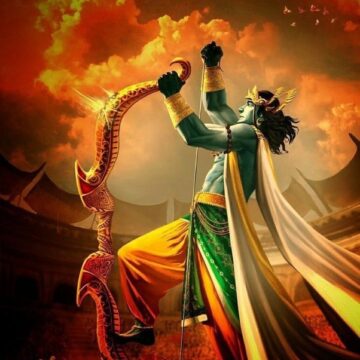Dr. Pingali Gopal recaps Sri Aurobindo's life, views and works; and argues that his teachings be an integral part of Indian education.
Category: <span>COMMENTARY</span>
Ājānubāhu (आजानुबाहु)
Ramesh Venkataraman explores Ājānubāhu, the concept, the synonymy of the word with Sri Rāma, and explores appearance of any other Ājānubāhu persons in history.
When Scientism Overshadows Science: An Orthodox Critique of the Sophistry of Evolutionism
"It is a modern tendency within religious factions to seek a synthesis and synchronization between the domains of Religion and Science. This inclination manifests in the attempts of forceful amalgamation of both domains, with the rejection of traditional interpretations of Religion and deliberate efforts to reformulate it to seamlessly align with the framework of Science."
Śaṅkara Charitam – a re-telling – Chapter16 – Ōṃkārēśvar to Kāśi
Śaṅkara sets off on his own towards Kāśi, at the behest of his Guru who tells him to spread the knowledge of the Vedas in Kāśi, because Kāśi is the epicenter of Dharma, the place where Śiva, dwells in every stone, tree, building, air, water, and soil.
How long did the demolition of the Kashi-Vishwanath Temple take?
In this paper, D Shrinivas uses the Maasir-i-Alamgiri of Saqi Mustad Khan to determine the dates on which the order for the destruction was given and the time it took for the destruction to actually be carried out. Based upon the above he hypothesizes about the resistance that Aurangzeb’s military likely faced from the local Hindu populace while carrying out the orders to destroy this Hindu temple.
Ayurveda: Tradition, Science, and Recognition in a Globalised World
Ayurveda, despite being a system as ancient as, and deeper and more effective than, the Traditional Chinese Medicine (TCM), does not yet enjoy the same reverential status accorded to TCM. Does the cause lie in its inability to fit into the modern lifestyle, or with us for failing to find and project pride in our own cultural heritage and treasures?
Śaṅkara Charitam – a retelling – Chapter 15 – Guru Parampara
Chapter 15 of Śaṅkara Charitam, titled Guru Parampara, takes us through the experience of Śaṅkara taking his leave from his Guru Govinda Bhagavatpāda and embarking on his journey to Kasi. The Guru Parampara, the lineage of the Gurus who preceeded Śaṅkara, is explored.
Ambedkarism: A Malediction Upon Indian Society — A Critical Evaluation of the Ideals of Equality, Affirmative Action, and the Pursuit of Social Justice
The elusive dream of ‘Equality’, whether in the form of ‘Opportunity’ or ‘Outcomes’, tantalises many, yet evaporates like a mirage in the real drama of human society. Do social justice, equality, and reforms reign supreme as transcendent values? Do religion, culture, tradition, and civilization solely encompass oppression and backwardness, or do they extend beyond the horizons of the contemporary cultural Marxist worldview we’ve embraced?
Harsh Sharma explores the effects of Ambedkarism on the above in the Indian context.
The Root of All Ideological Conflicts: Cultural Marxism
Jahnavi Naik explores the penetration of Marxism in society and culture, and delves deep into the phenomenon that is 'Cultural Marxism' - its definition, its reach, its methods; and examples from recent happenings in the country.
Varna And Birth
It is one of the strangest ironies that, despite being an intricate part of our daily lives, we do not have any theory explaining Varna, Jati, and Kula. It is also not clear whether caste, understood as a class system, can be the foundation for understanding the complex arrangement of Varnas and Jatis in Indian society. One of the biggest sources of contradictory strands is the issue of whether Varna is by birth or not.
Chittaranjan Naik concludes that birth is not the cause of Varna, as popularly understood; it is the identifier.










